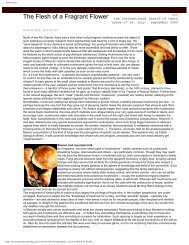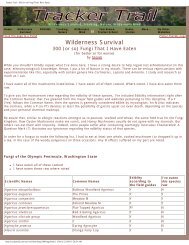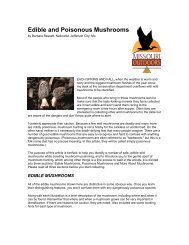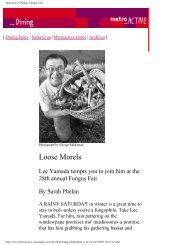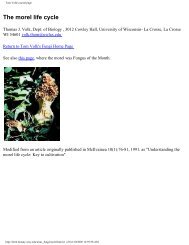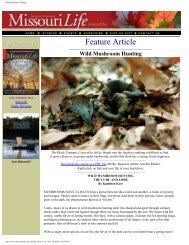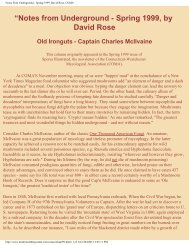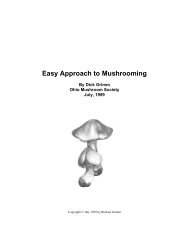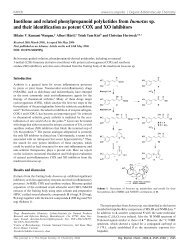Norwegian Chaga.pdf - The Mushroom Hunter
Norwegian Chaga.pdf - The Mushroom Hunter
Norwegian Chaga.pdf - The Mushroom Hunter
Create successful ePaper yourself
Turn your PDF publications into a flip-book with our unique Google optimized e-Paper software.
<strong>Norwegian</strong> Fungus of the Month February 2001<br />
<strong>Norwegian</strong> Fungus of the Month - February 2001<br />
Inonotus obliquus (Fr.) Pilat<br />
(Hymenochaetaceae, Hymenochaetales, Basidiomycota)<br />
Inonotus obliquus is an interesting polypore,<br />
as it has two completely different life<br />
stages. In Norway, the species is more or<br />
less restricted to Betula, where it makes<br />
itself evident by large black cankers, often<br />
located high above the ground on living trees.<br />
This stage is perennial and the cankers grow<br />
to large sizes, often 20 cm or more in<br />
diameter and 5 to 10 cm thick. <strong>The</strong><br />
consistency is very hard and one needs an axe<br />
to remove it from the trunk. <strong>The</strong> inner parts<br />
of the canker are dark brown with a pattern<br />
of white spots. <strong>The</strong>re is no production of<br />
conidia or similar dispersal units from the<br />
surface of the black canker, and its function<br />
or purpose is a mystery.<br />
<strong>The</strong> growth form reminds one of a tumour, and the popular <strong>Norwegian</strong> name is<br />
"kreftkjuke" i.e. cancer polypore. In Russia, the fungus has been used for<br />
treatment of all sorts of ailments, such as stomach cancer, as told by<br />
Solsinitjin in his famous book “Gulag Archipelago”. However, in Scandinavia<br />
this use is unknown.<br />
Because the fungus begins by attacking only the central trunk as a heartrot,<br />
an infected tree can live with I. obliquus for many years, as no harm is done<br />
to the peripheral and more vital parts of the trunk. However, in the end, such<br />
trees die, usually as a standing trunk loosing it’s branches.<br />
<strong>The</strong> summer after the tree has died, the bark splits and a brown resupinate<br />
basidiocarp develops on the exposed wood. Since this happens while the tree<br />
http://www.uio.no/conferences/imc7/NFotm2001/February2001.htm (1 of 2)1/14/2006 2:35:21 PM
<strong>Norwegian</strong> Fungus of the Month February 2001<br />
is standing, the pores are usually very oblique, thus the Latin epithet. <strong>The</strong><br />
basidiocarp are very rapidly eaten by insects, which probably help with<br />
dispersal.<br />
Strangely enough, the perfect poroid basidiocarp develops only once. Later<br />
on, several other polypores colonize the wood where the perfect basidiocarp<br />
grew. Gloeoporus dichrous (Fr.) Bres. is one of the species that frequently<br />
occur in such places.<br />
http://www.uio.no/conferences/imc7/NFotm2001/February2001.htm (2 of 2)1/14/2006 2:35:21 PM



